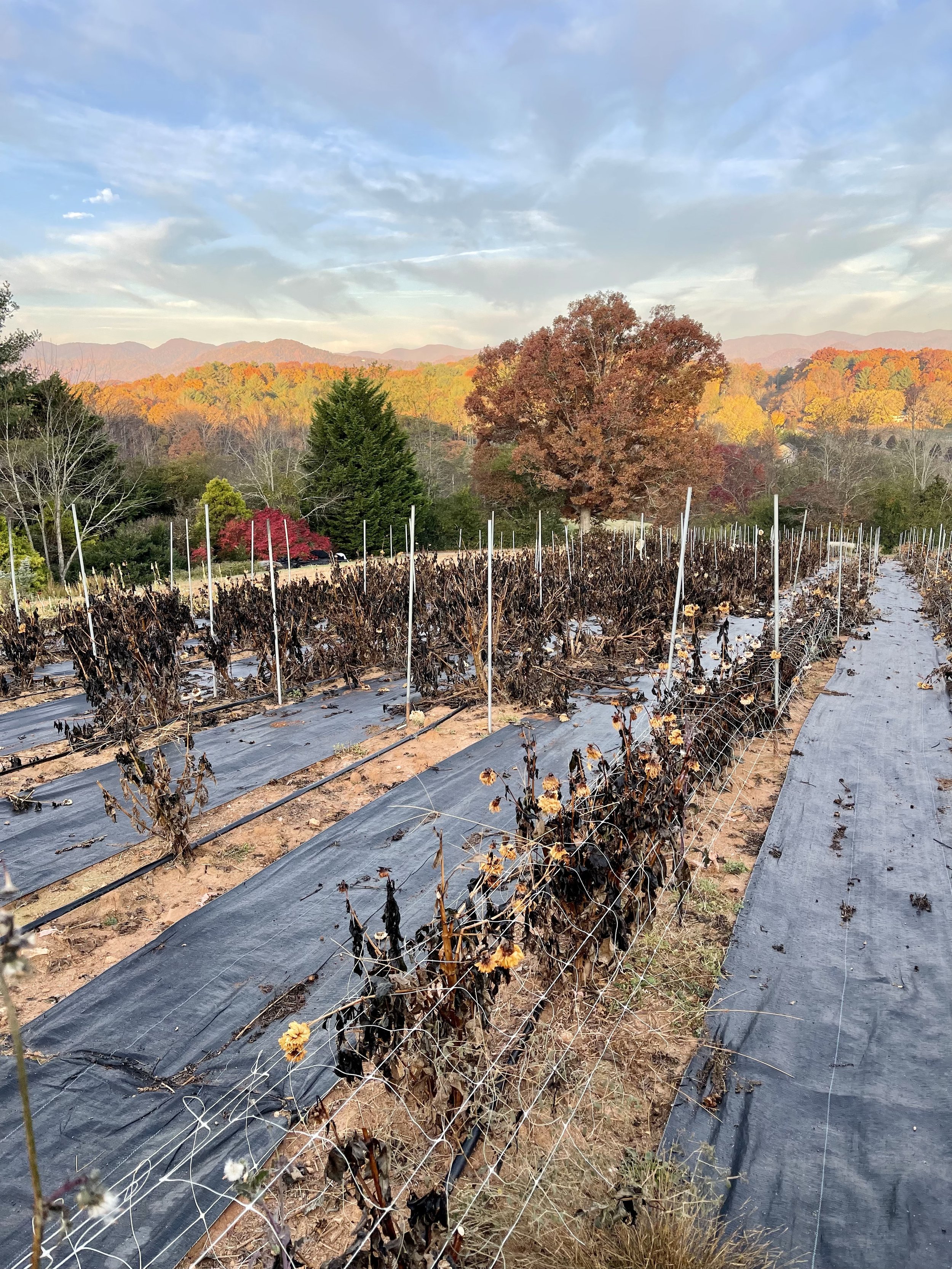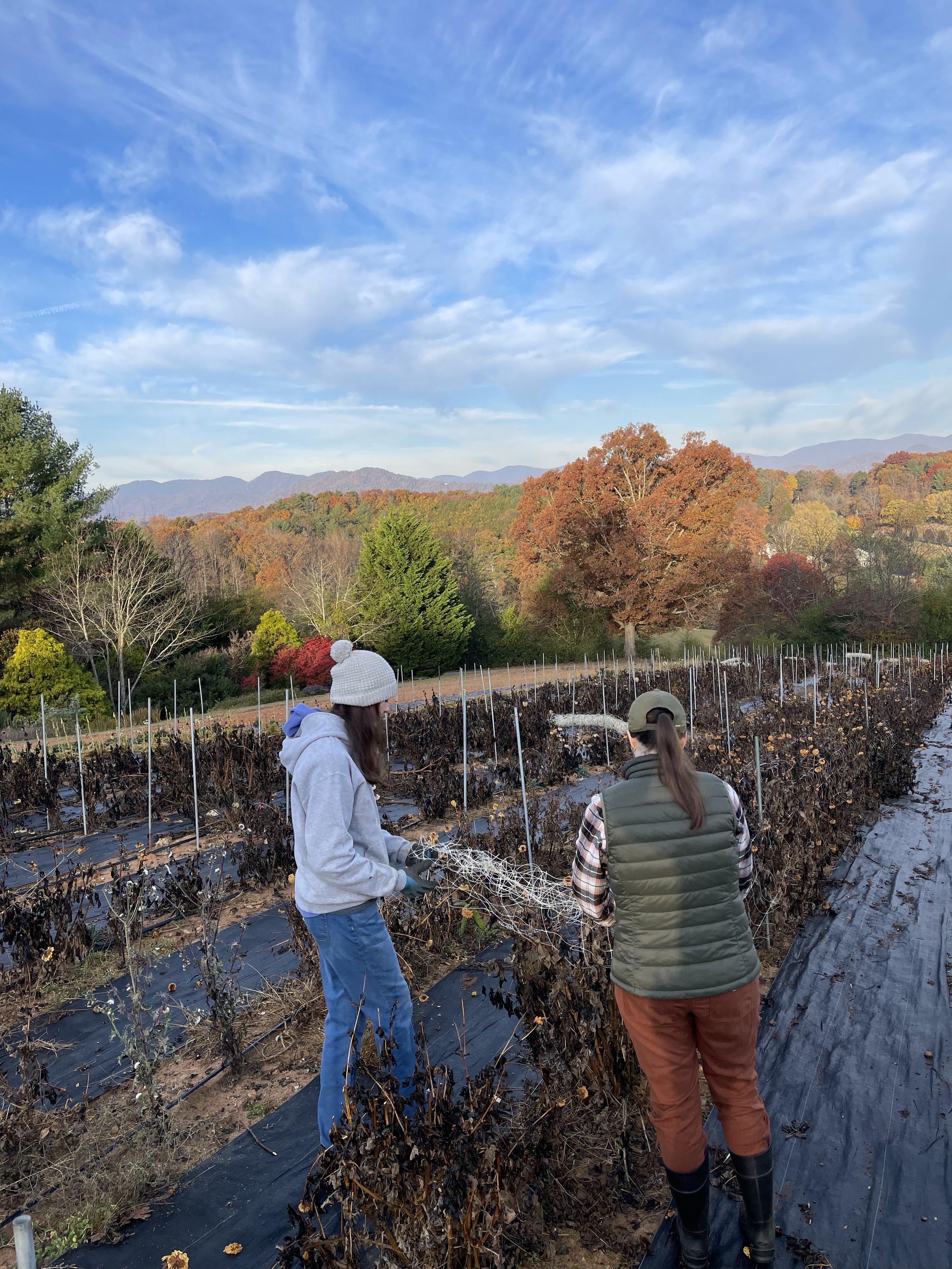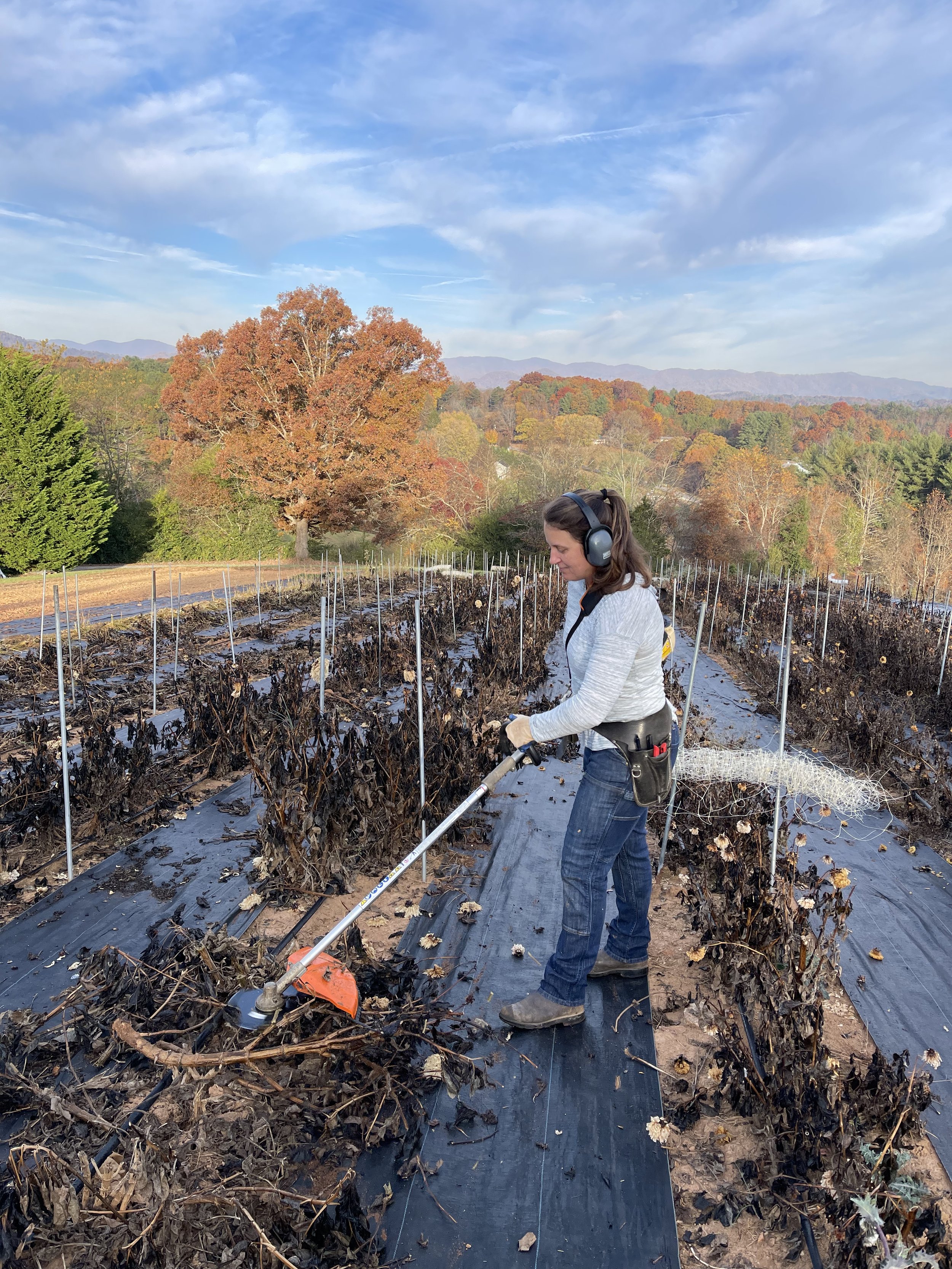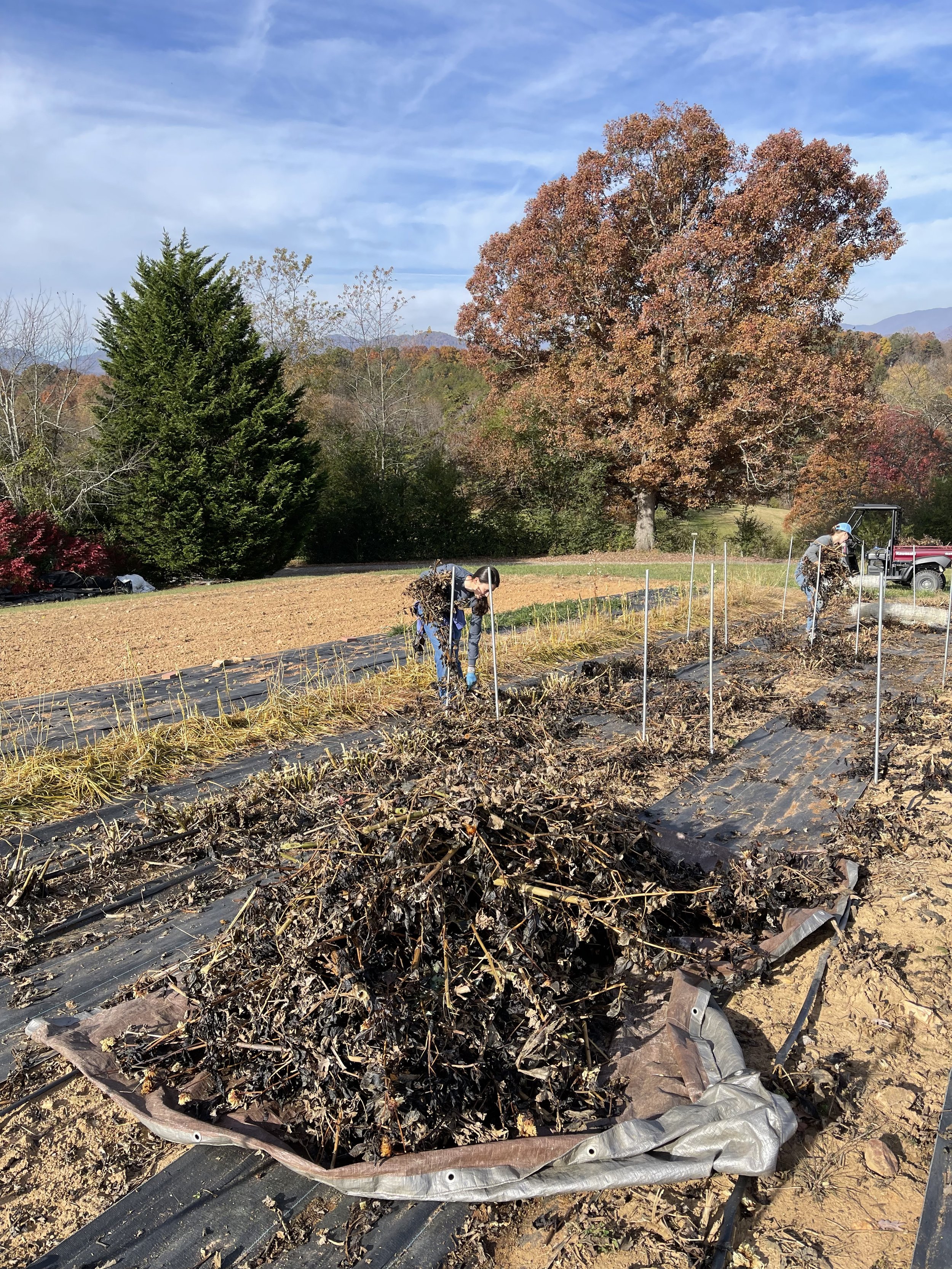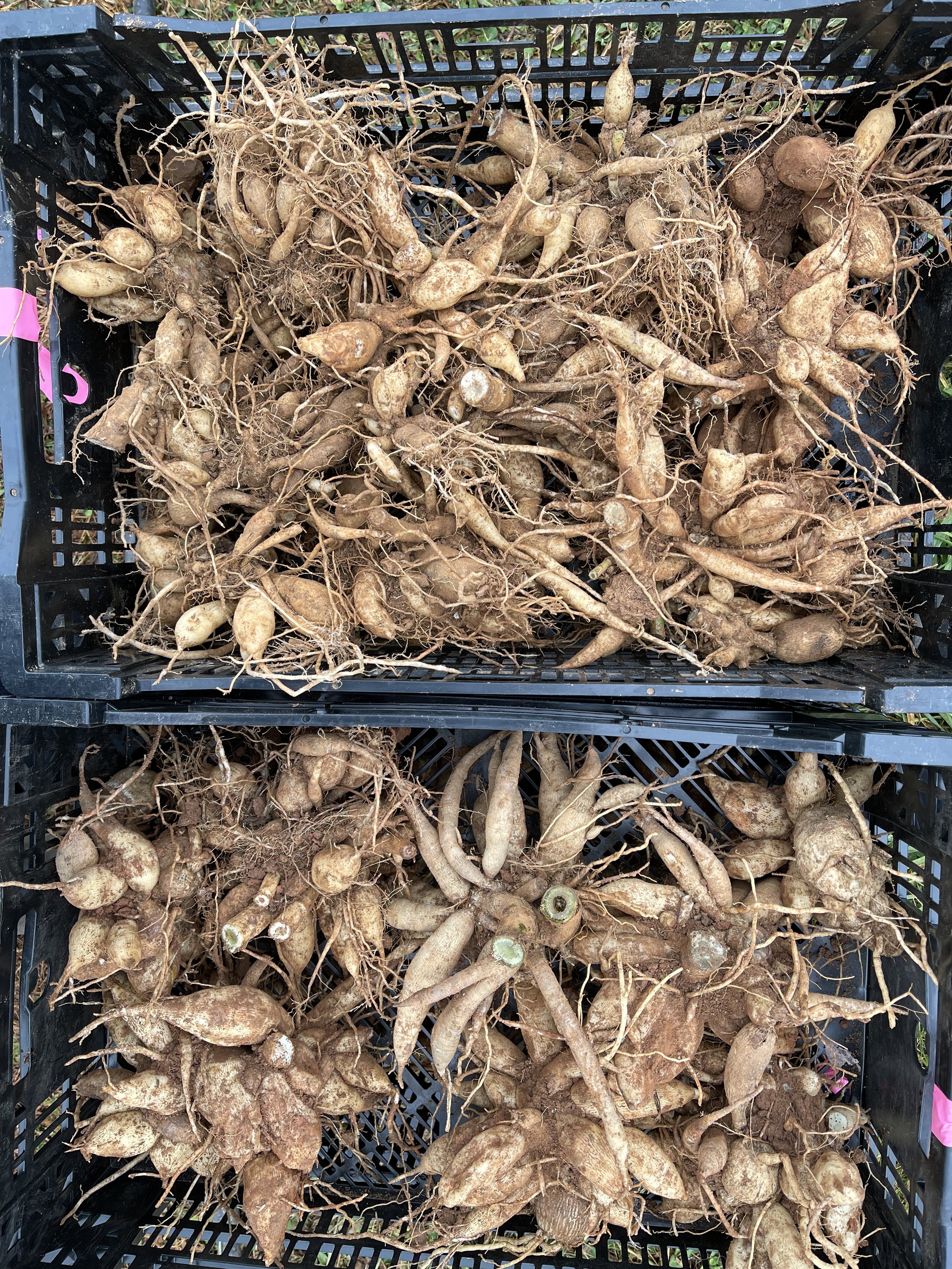Overwintering Dahlias
/I’ve been promising to write this blog post for almost a year, and I finally sat down at the computer to get it posted (which is no easy feat in the fall season!). I want to start with a disclaimer that overwintering dahlias is not possible in every climate. You need 2 important things to successfully leave tubers in the ground over the winter: (1) the ground cannot freeze because your tubers will also freeze and die and (2) you need excellent drainage so the tubers do not rot. Generally, growers in USDA Hardiness zones 6+ can leave their tubers in the ground over the winter (we are in zone 6b here in Western North Carolina). If you grow in a warm climate and there’s no chance your ground will ever freeze yet it is unbearably hot in the summer, you can “over-summer” your tubers in the ground as long as your soil drains really well.
Another disclaimer: no method, whether its overwintering tubers in the ground or digging and storing them over the winter, is 100% perfect. We do experience some loss with leaving tubers in the ground, but only about 5% or less. I am comfortable with those are odds because we experienced roughly the same amount of loss while digging, dividing and storing tubers over the winter.
THE PROS OF OVERWINTERING DAHLIAS:
Significantly less work than digging, dividing and storing tubers. There is a reason that this is listed as #1… the amount of work it saves is astronomical!
You’ll have flowers blooming much earlier in the season. We typically have dahlias blooming in late May or June (weather depending).
Larger, more robust plants with a larger number of stems and blooms per plant.
Less (or no) pinching required.
THE CONS OF OVERWINTERING DAHLIAS:
The potential for loss of tubers over the winter due to freezing, rotting or rodents.
You are not increasing your stock because you are not dividing the tubers. However, this is only a con if you want more dahlias. We already grow as many as we have space for and that we have the capacity to harvest and care for. Also, see #3 from the list of pros.
By having dahlias bloom earlier in the season, the plants will be tired and less productive in the fall. Keep reading though… I have a solution for this!
Dahlias bloom earlier in the summer when insect pressure tends to be stronger.
After experimenting with overwintering dahlias for 4 seasons now, I’ve discovered a few tips and tricks for a longer, healthier dahlia season.
overwintering tips
Plant tubers further apart to allow for the extra growth of the plants in years to come. I recommend at least 2’ apart. Spacing the plants further promotes better airflow, minimizing disease and fungal issues.
Have a plan for insect pressure. Because we grow organically, but are not certified organic, we rely on beneficial insects to combat the bad bugs on our farm. The bugs that give us the most trouble are aphids, thrips, grasshoppers and Japanese beetles. For beetles: We have been applying beneficial nematodes to our soil for 2 years now and have seen a dramatic decrease in the number of beetles. We also use pheromone traps when needed to lure the Japanese beetles away from our crops. For grasshoppers: We rely on birds to help control the grasshoppers and keeping the support stakes/posts in our dahlia field year round provides the birds excellent places to perch while hunting. We humans also use our snips to cut grasshoppers in half – it sounds brutal, but you get used to it. For thrips and aphids: We release ladybugs, minute pirate bugs and green lace wings every other week for 8 weeks beginning in May. We purchase all of our beneficial insects from Arbico Organics.
Succession plant your dahlias! Knowing that because our dahlias begin blooming so much earlier than spring-planted tubers (early June versus late July), we plant a fresh round of tubers in late June. We know that dahlias are still in high demand during the fall months of September and October, and by that time our overwintered plants are producing less because we have already been harvesting heavily for 3+ months. These newly planted tubers begin blooming in late August and will bloom until the first hard frost. We plant a much smaller quantity of tubers in late June compared to the amount of tubers that are overwintered – every farm or garden is different and we’ve found that is what works for us.
In the fall, flag and remove any dahlia plants that you do not wish to keep for next year. By the time spring rolls around, you will have forgotten where those plants are. Place a flag or mark the space to plant new tubers the following spring.
Keep your dahlias watered well and apply fertilizer throughout the season. We use drip irrigation on our dahlias and water 2x per week during very dry spells with no rainfall. We top-dress our overwintered plants with a well-balanced organic fertilizer in May and July.
Our farm is located on a very large hill, with our rows extending downhill, and have excellent drainage so we do not cover our overwintering dahlia tubers with mulch or plastic. Mulching with straw and covering with plastic may be something to consider if you worry about the ground freezing or too much rain/snow in the winter causing the tubers to rot.
DIGGING & STORING TUBERS
At the end of the season, we dig up the tubers that were planted in June to store over the winter and plant fresh again the following summer, allowing us to continue the cycle of succession planting dahlias. Once the plants are killed by a freeze, or you are ready to dig them up, remove any support netting and cut the foliage to the ground. Be sure to label your tubers with flagging tape before frost or before you cut them back, otherwise you’ll have no idea what’s what the next year. We use a blade attachment for a string-trimmer to cut the dahlia stems/foliage, but hedge trimmers or shears work too. Gather all the foliage and move to compost or burn pile.
We use a landscape fork to gently remove the tuber clump from the ground. Shake off any excess dirt and cut the stem lower if needed. We do not rinse our tubers in the fall so that they are very dry going into storage. Dahlias can be divided in the fall or spring, and we choose to divide in the late winter when the eyes are more visible and we have more time. We pack the clumps of tubers in crates and they are stored in the basement where it is cool (but well above freezing), dark and dry. About once a month, I check the tubers for rot or mold. If I notice any signs of mold, I lightly spray it with a very diluted bleach solution. If the tubers are shriveling that means they’re too dry; spritz with clean water to rehydrate.
There are many more steps involved with dividing tubers and storing divided tubers, but hopefully this post gives you some information to think about regarding overwintering dahlia tubers. This is just how we do things on our farm – there is no right or wrong way as long as you get the results that you want!
xo Niki





